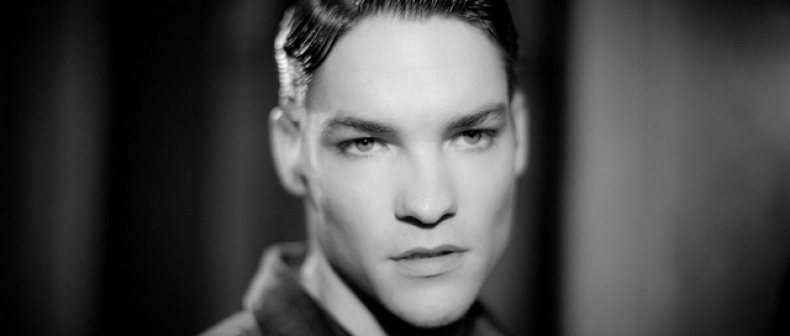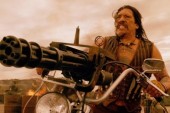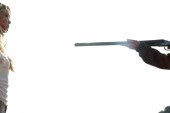
Daivd Wontner in Guy Maddin’s Keyhole
What’s the old expression? The guys you have to worry about are always the ones you least suspect? In conversation, director Guy Maddin is a charming, gregarious, and joyful man. Based on his personality, one might assume his movies are sweet little stories filled with whimsical nostalgia for his home base of Winnipeg. Yet, Maddin has possibly the strangest imagination in the Canadian film industry, and considering that his main competitor for the crown is David Cronenberg, that’s saying a lot. From his 1989 debut Tales Of The Gimli Hospital to recent efforts like Brand Upon The Brain!, the filmmaker has specialized in darkly surrealist movies shot in the flickering monochrome of the silent era. He’s an uncompromisingly original artist who has never made concessions to mainstream audiences, carving out a comfortable niche as Canada’s answer to other perverse sweetheart directors like David Lynch.
Maddin’s latest film Keyhole starts out seemingly rooted in comfortable genre movie origins when a group of gangsters led by Jason Patric stumble into an abandoned house haunted by the ghost of Isabella Rossellini. While that might be a strange enough combination of elements for some filmmakers, it’s only the start for this guy. Things gradually slide into the wild dream logic of Maddinville, a magical land where ghosts scream “Yahtzee” while masturbating and gold dust is found in pubic hair.
The Toronto Standard got a chance to speak to the incomparable director on the eve of Keyhole’s theatrical release, discussing everything from his unexpected Odyssey influences to working a Kids In The Hall cast member into his strange world.
Since Keyhole starts with familiar genre movie elements before spiralling into something else, I was wondering if that was what happened when you were writing the movie?
[Laughs] Well, you know I’ve been told for years that my films were impossible to classify and I’d always say, “thank you.” But a number of distributors and fellow filmmakers would say, “you like genre films, right? You’d really be doing everyone a favour if you just made a genre film.” I accidentally made one once when I accepted a job directing a ballet version of Dracula [Dracula: Pages From A Virgin’s Diary], which was a mash up of a dance film and a vampire film and shockingly did better than anyone expected. It was made just for a single television broadcast and ended up getting released theatrically. I thought, “shit, maybe there’s something to this.” With a genre, movie people know what they’re getting whereas my other stuff is like an incest mountain movie. What the hell?
So I thought I’d take two of my favourite genres–ghost stories and gangster movies–and just mash them up. It was supposed to be like Cowboys and Aliens where you know what you’re getting. But you know, obviously I haven’t made a box-office blockbuster or anything. I kind of cheated, too. I really like the atmosphere of a gangster movie where there are very fierce loyalties that are betrayed on the turn of a dime. These kind of super unstable childhood stories like the episodes of The Untouchables are what I grew up watching on TV. Then there were other more personal influences as well. Most of my most cherished childhood memories are of my home and I really wanted to make a movie about a home. So I thought I would revert to these childhood genres of ghost stories and gangster pictures that were beloved genres for me growing up.
Was that partly a conscious attempt to move out of the autobiographical movies you have been making recently like My Winnipeg?
Yeah, but I also thought I could secretly sneak in a lot of autobiographical themes as well. Because the home you grow up in really defines you and shapes you. I thought just by not having a character named Guy Maddin, it might help mask that a little bit and also having a fictional story based loosely on the structure of The Odyssey. But even there, when I read the Wikipedia synopsis of The Odyssey it sort of matched my own boilerplate biography anyways. You know, Ulysses being away from home for 19 years. The son dreaming of his father back into existence and dreaming his way back home. These things really matched up with a lot of dead father dreams I had when I was a young man. I always felt in my dreams that my father hadn’t died, that he had actually abandoned the family instead, but was coming home. So I realized that I was actually dreaming The Odyssey for 30 years before ever reading the Wikipedia synopsis. Then I read the Lattimore translation of it and realized that Homer had a father who died on him young, and abandoned the family. There’s no way, as much of a genius as Homer was, the story didn’t come out of that feeling.
So, there are a number of personal influences like that. As a child, every time you go to the home of one of your friends, every home seems to have it’s own tenor, it’s own tone. It’s almost like you hit a tuning fork when you cross the threshold. A house has its own sense of gloom or a mildew-iness, or a cheeriness, or a welcomeness or something sexually creepy or sexually open. Every house seems to be a little different and it seems to be determined by generations of memories and the ways that people in the house not just decorate it, but the way they react to certain things. I just realized that every house is haunted, not with ghosts but with memories. So I was interested in interchanging ghosts and memories freely in this story. That’s why the ghosts aren’t scary, because memories aren’t often very scary. Even memories of scary things seem to just fill you with an anger or regret or melancholy. So ghosts are anything but scary, they’re actually usually melancholic or horny [laughs]. And then, just for practical concerns, I decided not to make a real gangster movie. I just liked the idea of people who you couldn’t quite trust and memories that you can’t quite trust. I didn’t want to keep track of who had a gun and who didn’t, who was going to double cross whom and that sort of thing. So I had them toss their guns in the garbage. It was very Canadian of me.
How did Kevin McDonald end up in the movie? He’s fantastic, but I definitely did not expect to see a sketch comedy veteran in your film.
I’ve always liked the ensemble casts in ghost stories and gangster films where there would be a large cast. There’d be someone with a British accent, someone with a Brooklyn accent, someone who was gay, by codified old screen terms. There would be a real array of people with many different acting styles, some very naturalistic and some very flamboyant. I wanted to make a movie like that because I thought I’ll never be an actor’s director with a specific style of acting from top to bottom. So, to get that tone, I thought Kevin would be perfect. I always found him funny and even in Kids In The Hall there was always an array of performance styles and he felt like that extra joker card. Plus, he’s a Winnipegger now, so he was right there and I love him. So I wanted to use him.
How did you find shooting entirely digital for the first time?
I liked it. I had been meaning to take the plunge to the digital realm for a long time. I was scared of turning into the last man who used film, standing there on a penny-farthing, fat, and wearing a bowler. With My Winnipeg, I shot most of it digitally, but then chickened out at the last second and projected the footage and reshot it onto film. This time, we were $70,000 short and we could save $70,000 just by shooting digitally. So I took that as the big push into the water and I’m glad I did. I liked it.
The movie still has a very filmic quality to the visuals, was that hard to achieve digitally?
No, it was pretty simple. I just ran a couple of tests. There are a number of different filters you can put on and I put on a Pro Mist 2 and then blew it up onto 35mm film. It looks digital, but it looks fine. I used to tell myself that that certain stories, especially stories that were nostalgic or about memories belonging to the realm of emulsion, should be shot on film. But all those things that haunt us have been around for thousands of years whereas photography has only been around since 1827. If you’re a real artist, you should be able to evoke all of those feelings with digital media as well. There’s so much beauty and potential in digital photography that to dismiss it as ugly is completely wrong. It’s ugly in the wrong hands, not if you try to make it beautiful.
I read somewhere that you felt in Keyhole you had managed to capture your dream life in a way you didn’t think you had before–
Yeah. You know, there is a cost to making something this wall-to-wall dreamlike. You lose viewers. It makes real time slow down and things like that. It makes people angry at you and accuse you of wanking [laughs]. So maybe I could have done myself a favour by structuring the framework a little more rigorously. But I don’t know. The first half of the movie set itself up in an almost Robert McKee “how to write screenplays” textbook style, that all the ghosts and memories started talking to each other and sort of pushed the director off to the side. I felt that they were all behaving the way they should and if people watching get confused, at least it’s the way you get confused in a dream. They all seem honest. They are all behaving according to character. I started cutting the movie down so that at least it wouldn’t be three hours long and thought that I’d take a chance on this being impenetrable and maybe it’ll have a longer shelf life as a result. Maybe people will come back to it in a couple of years and experience it differently. I’m pretty pleased by the density of the atmosphere of the thing, so maybe some people will return to it in the way you might go back to a symphony a few years down the road and hear something new.
Does it bother you if people react negatively when they don’t understand your films on the first pass, or do you enjoy that they provoke a strong reaction?
Only occasionally have I mischievously enjoyed poking anger out of people. I’m not that kind of person. For the most part, I really want to make a connection with an audience. I try to do it on my terms, because I want to show them something new. I know I run the risk of not reaching everybody and I’m not even sure if I’d like my own movies if I hadn’t made them. But it’s just something that I’m driven to do. It was really instructive presenting two feature films, Brand Upon The Brain! and My Winnipeg with live elements. Especially My Winnipeg, where I narrated it myself. I felt much more like a showman than a filmmaker. A filmmaker implies that you make something for yourself, but a showman tries to engage the audience. So, I was a filmmaker while shooting it, but I was a showman while presenting it. I could always energize my narration a bit more if I felt people sinking into their seats. I would even single out people going to the washroom and extort a promise to return out of them and that sort of thing. So I really grew addicted to the low walkout rate on those movies. I think there was virtually none and I liked that. So, I knew I was in for a bit of a backslide on this picture because it didn’t have live elements. And there were also some things that I’d change on the fly if I could, but you just can’t do that. That’s not what filmmaking is. I really want to reach people, but when you’re making a film without live elements, you’ve got to anticipate how involved people are and do all the things that all the great movie masters did. It’s hard, especially when you’re going into slightly uncharted territories.
What can you say about the new project you’re working on that will recreate old lost films?
That’s a project I’ve started called Spiritismes. Udo Kier who was in Keyhole and did narration for Brand Upon The Brain! stared in one of those. It’s something I keep working on in various places around the world. I shot at the Centre Pompoidou in Paris with Udo, I shot at the MOMA in New York. I’m planning to shoot some in Winnipeg and some in Brazil and a few other places.
What’s the end goal for that? Will it be released theatrically or be an art gallery piece?
It’s going to sort of straddle the internet world, the gallery world, and the theatrical world. It’s mostly going to be at a website that anyone can visit and will pay homage to cinema. Basically there will be movies in it combined and recombined as fragments through endless, infinite permutations. Sort of a confused clamor of narrative voices coming from the past. It’s been really challenging, but it feels worthwhile. It feels like something no one has done before. I feel like a real pioneer, not the faux pioneer I’ve been for years.
_____
Phil Brown writes about classic films for Toronto Standard‘s Essential Cinema column.
For more, follow us on Twitter at @TorontoStandard and subscribe to our newsletter.














